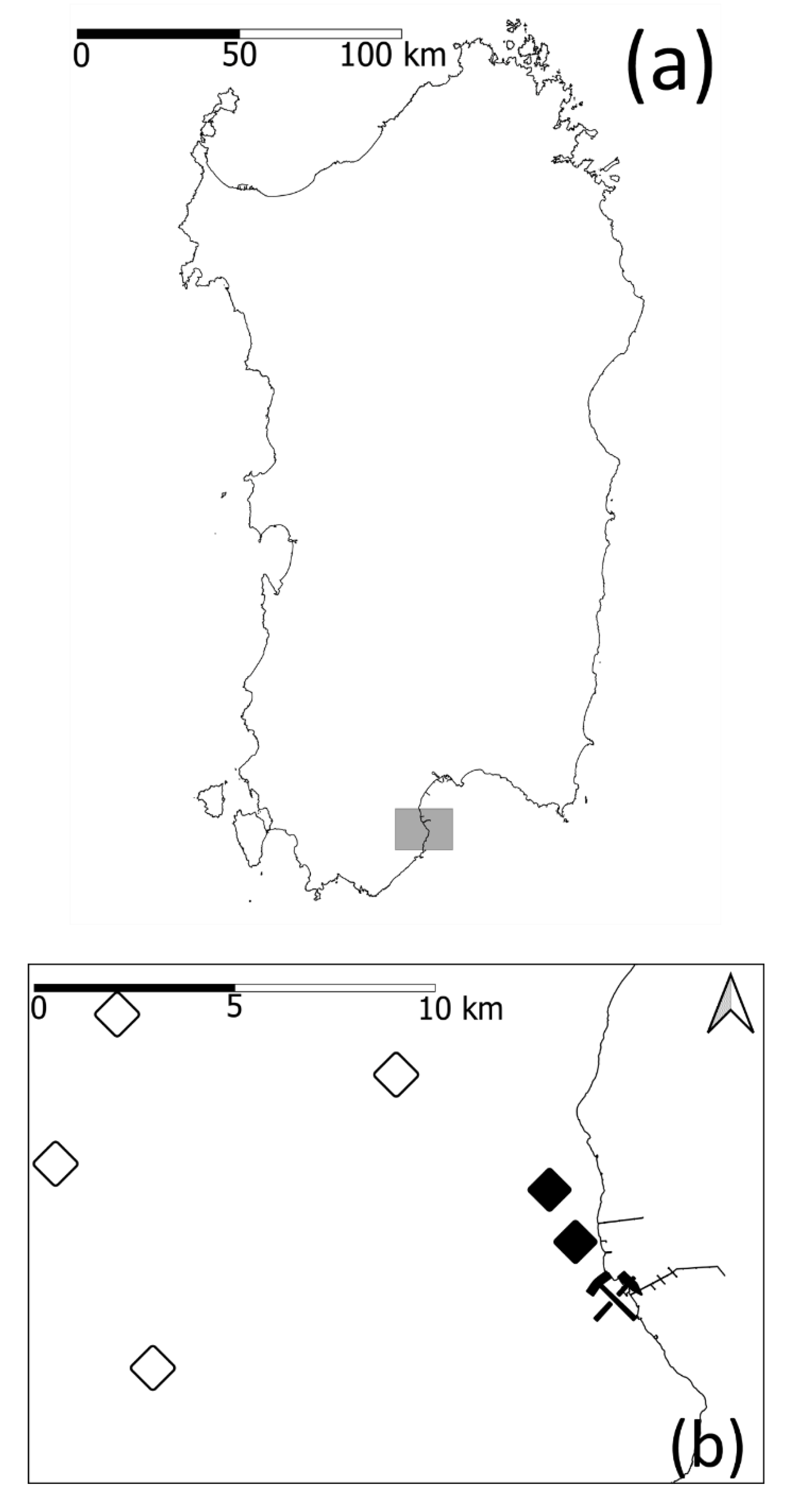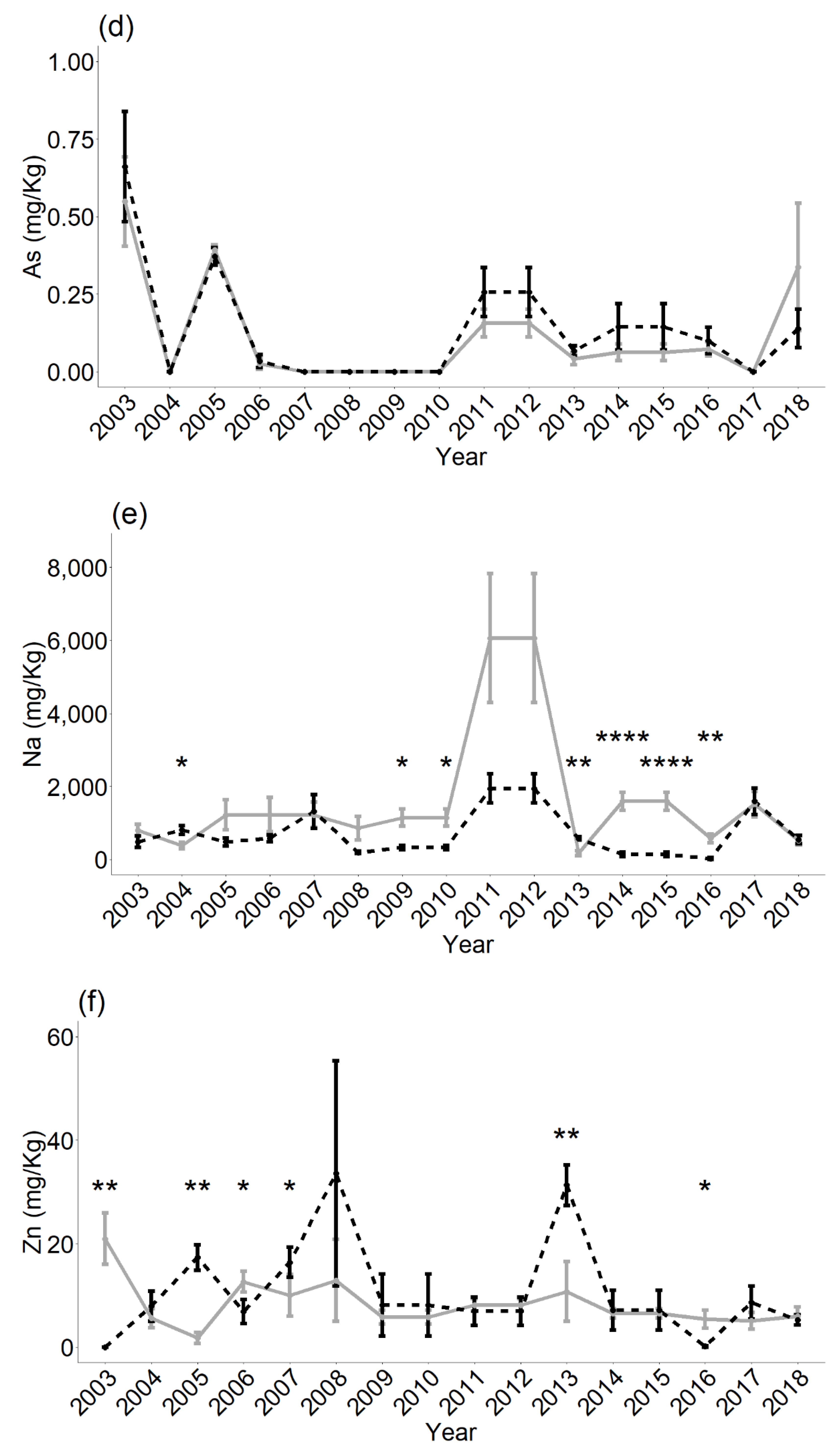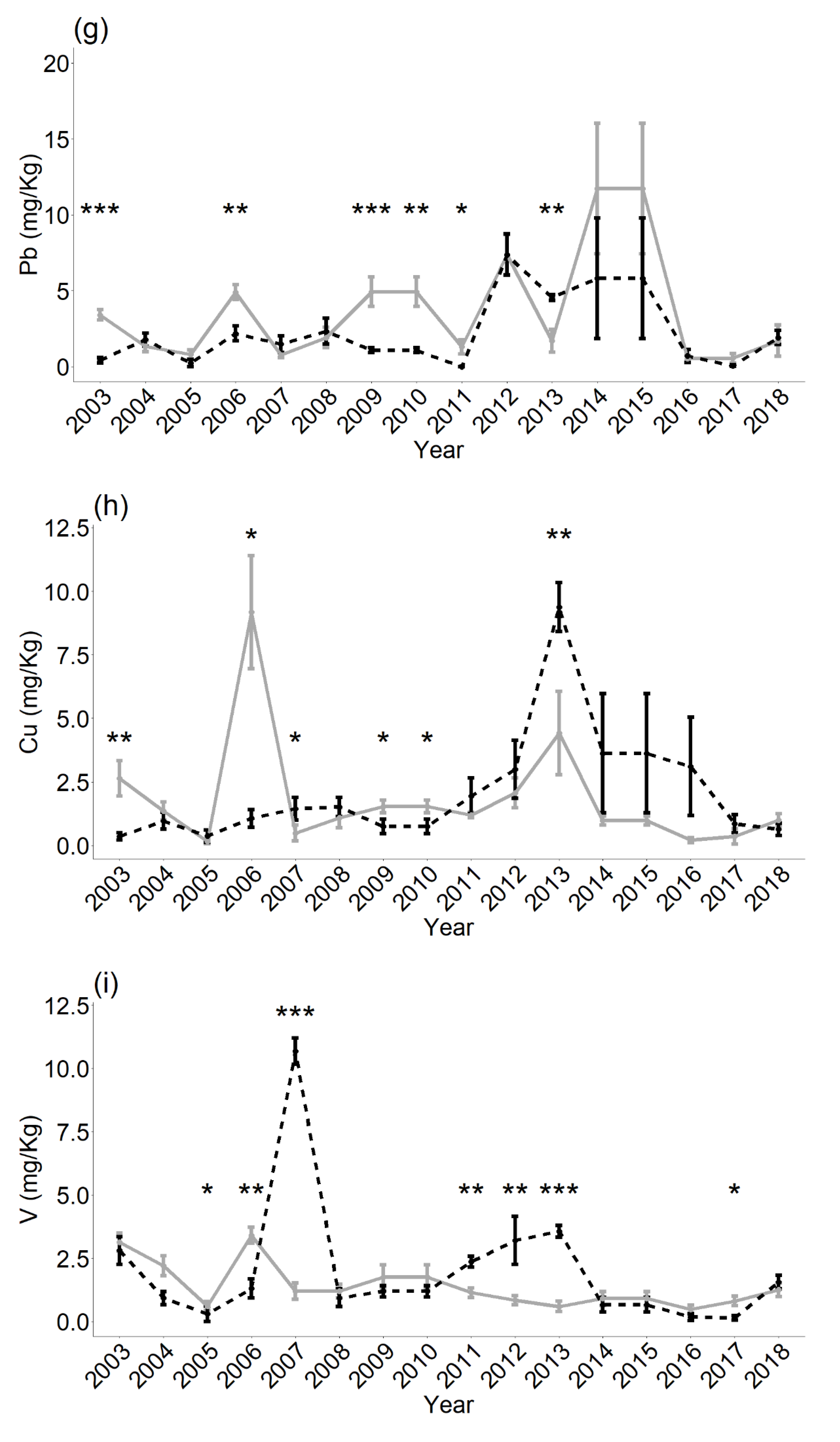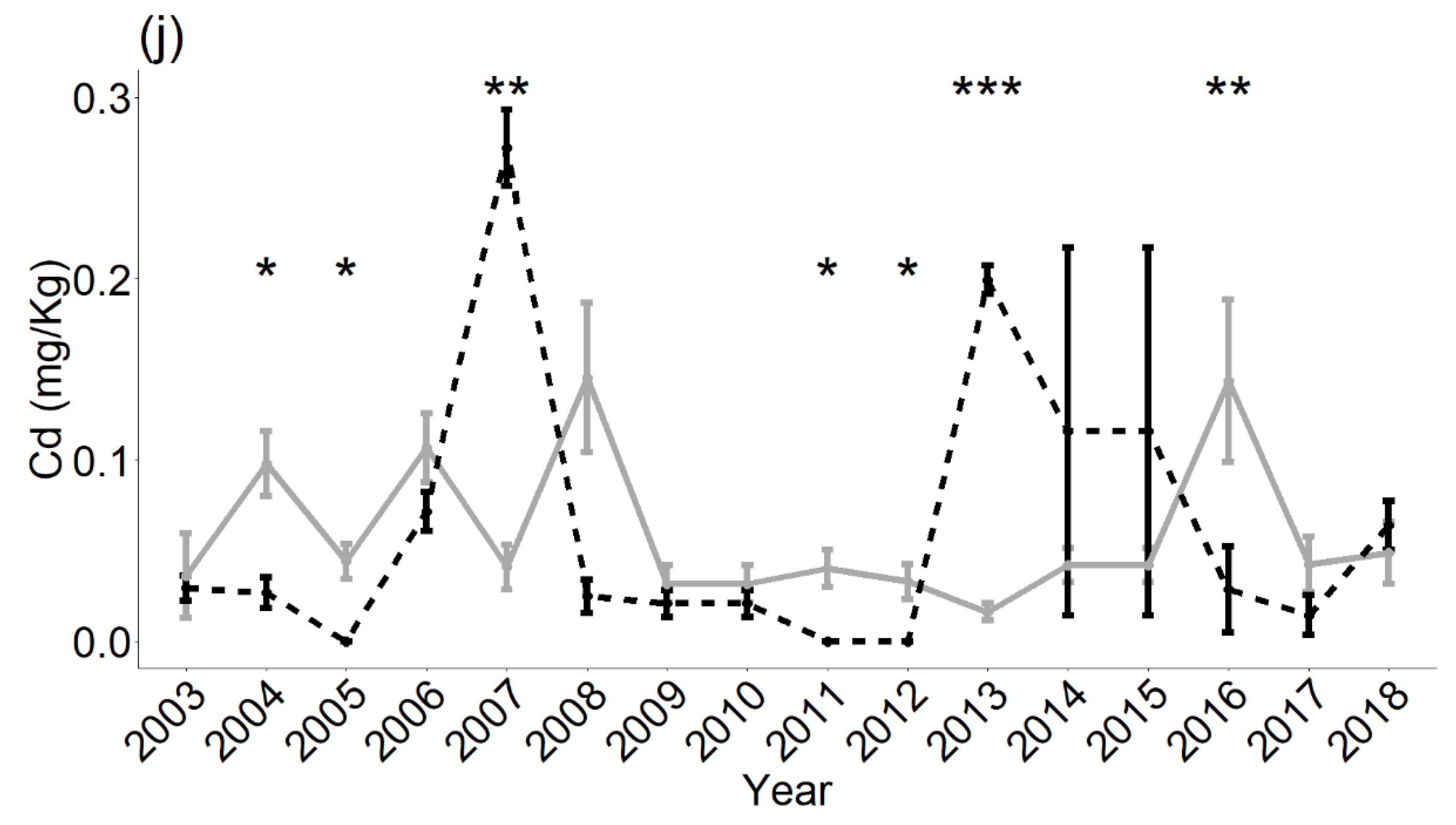Monitoring of Air Pollution by Moss Bags around an Oil Refinery: A Critical Evaluation over 16 Years
Abstract
1. Introduction
2. Materials and Methods
2.1. Study Area
2.2. Moss Bags
2.3. Sampling Design
2.4. Chemical Analysis
2.5. Data Analysis
3. Results
3.1. Element Accumulation in Relation to Exposure Conditions
3.2. Temporal Fluctuations in Pollutant Content
3.3. Dispersion of Accumulation Data
4. Discussion
4.1. Air Quality and Industrial Emissions
4.2. Ecological Factors Influencing Biomonitoring Results
5. Conclusions
Author Contributions
Acknowledgments
Conflicts of Interest
References
- Wolterbeek, B. Biomonitoring of trace element air pollution: Principles, possibilities and perspectives. Environ. Pollut. 2002, 120, 11–21. [Google Scholar] [CrossRef]
- Arnold, S.M.; Angerer, j.; Boogard, P.J.; Hughes, M.F.; O’Lone, R.B.; Robinson, S.H.; Schnatter, A.R. The use of biomonitoring data in exposure and human health risk assessment: Benzene case study. Crit. Rev. Toxicol. 2013, 43, 119–153. [Google Scholar] [CrossRef]
- Cortis, P.; Vannini, C.; Cogoni, A.; De Mattia, F.; Bracale, M.; Mezzasalma, V.; Labra, M. Chemical, molecular, and proteomic analyses of moss bag biomonitoring in a petrochemical area of Sardinia (Italy). Environ. Sci. Pollut. Res. 2016, 23, 2288–2300. [Google Scholar] [CrossRef] [PubMed]
- Pleil, J.D.; Williams, M.A.; Sobus, J.R. Chemical safety for sustainability (CSS): Human in vivo biomonitoring data for complementing results from in vitro toxicology—A commentary. Toxicol. Lett. 2012, 215, 201–207. [Google Scholar] [CrossRef] [PubMed]
- Beelen, R.; Raaschou-Nielsen, O.; Stafoggia, M.; Andersen, Z.J.; Weinmayr, G.; Hoffmann, B. Effects of long-term exposure to air pollution on natural-cause mortality: An analysis of 22 European cohorts within the multicentre ESCAPE project. Lancet 2014, 383, 785–795. [Google Scholar] [CrossRef]
- MacIntyre, W.H.; Harden, L.J.; Hester, W. Measurement of atmospheric fluorine. Ind. Eng. Chem. 1952, 44, 1365–1370. [Google Scholar]
- Thomas, W.; Herrmann, R. Nachweis von Chlorpestiziden, PCB, PCA und Schwermetallen mittels epiphytischer Moose als Biofilter entlang eines Profils durch Mitteleuropa. Staub Reinhalt. Luft. 1972, 40, 440–444. [Google Scholar]
- Gonzalez, A.G.; Pokrovsky, O.S. Metal adsorption on mosses: Toward a universal adsorption model. J. Colloid Interface Sci. 2014, 415, 169–178. [Google Scholar] [CrossRef]
- Chakrabortty, S.; Paratkar, G.T. Biomonitoring of trace element air pollution using mosses. Aerosol Air Qual. Res. 2006, 3, 247–258. [Google Scholar] [CrossRef]
- Berg, T.; Røyset, O.; Steinnes, E. Moss Hylocomium splendens used as biomonitor of atmospheric trace element deposition: Estimation of uptake efficiencies. Atmos. Environ. 1995, 29, 353–360. [Google Scholar] [CrossRef]
- Zeichmeister, H.G.; Hohenwallner, D.; Riss, A.; Hanus-Illnar, A. Variation in heavy metal concentrations in the moss species Abietinella abietina (Hedw.) Fleisch according to sampling time, within site variability and increase in biomass. Sci. Total. Environ. 2003, 301, 55–65. [Google Scholar] [CrossRef]
- Cauto, J.A.; Fernandez, J.; Aboal, J.R.; Carballeira, A. Active biomonitoring of element uptake with terrestrial mosses: A comparison of bulk and dry deposition. Sci. Total Environ. 2004, 324, 211–222. [Google Scholar] [CrossRef] [PubMed]
- De Caritat, P.; Reimann, C.; Bogatyrev, I.; Chekuskin, V.; Finne, T.E.; Halleraker, J.H.; Kashulina, G.; Niskavaara, H.; Pavlov, V. Regional distribution of Al, B, Ba, Ca, K, La, Mg, Mn, Na, P, Rb, Si, Sr, Th, U and Y in terrestrial moss within a 188,000 km2 area of the central Barents region: Influence of geology, seaspray, and human activity. Appl. Geochem. 2001, 16, 137–159. [Google Scholar] [CrossRef]
- Berg, T.; Steinnes, E. Use of Mosses (Hylocomium splendens and Pleurozium schreberi) as biomonitors of heavy metal deposition: From relative to absolute deposition values. Environ. Pollut. 1997, 98, 61–71. [Google Scholar] [CrossRef]
- Gjengedal, E.; Steinnes, E. Uptake of metal ions in moss from artificial precipitation. Environ. Monit. Assess. 1990, 14, 77–87. [Google Scholar] [CrossRef]
- Brown, D.H.; Beckett, R.P. Differential sensitivity of lichens to heavy metals. Ann. Bot. 1983, 52, 51–57. [Google Scholar] [CrossRef]
- Seaward, M.R.D. The use and abuse of heavy metal bioassays of lichens for environmental monitoring. In Proceedings of the 3rd International Conference of Bioindicators, Deteriorisations Regionis, Liblice, Czechoslovakia, 12–16 September 1977; Academia: Praha, Czech Republic, 1980; pp. 375–384. [Google Scholar]
- Ares, A.; Aboal, J.R.; Carballeira, A.; Giordano, S.; Adamo, P.; Fernández, J.A. Moss bag biomonitoring: A methodological review. Sci. Total. Environ. 2012, 432, 143–158. [Google Scholar] [CrossRef]
- Castello, M.; Cenci, R.M.; Gerdol, R. Proposte metodologiche per l’uso di briofite come bioaccumulatori di metalli in traccia. In Proceedings of the Biomonitoraggio della Qualità dell’Aria sul Territorio Nazionale, Roma, Italy, 26–27 November 1998; Volume 2, pp. 233–240. [Google Scholar]
- Capozzi, F.; Giordano, S.; Aboal, J.R.; Adamo, P.; Bargagli, R.; Boquete, T.; Di Palma, A.; Real, C.; Reski, R.; Spagnuolo, V.; et al. Best options for the exposure of traditional and innovative moss bags: A systematic evaluation in three European countries. Environ. Pollut. 2016, 214, 362–373. [Google Scholar] [CrossRef]
- Bacchetta, G. Flora vascolare del Sulcis (Sardegna Sud-Occidentale, Italia); Universidad del País Vasco: Leioa, Spain, 2006; pp. 27–29. [Google Scholar]
- R Core Team. A Language and Environment for Statistical Computing; R Foundation for Statistical Computing: Vienna, Austria, 2019. [Google Scholar]
- Ares, A.; Fernández, J.A.; Aboal, J.R.; Carballeira, A. Study of the air quality in industrial areas of Santa Cruz de Tenerife (Spain) by active biomonitoring with Pseudoscleropodium purum. Ecotoxicol. Environ. Saf. 2011, 74, 533–541. [Google Scholar] [CrossRef]
- Uyar, G.; Elif, A.; Ören, M.; Karaca, F.; Öncel, M.S. Determination of heavy metal pollution in Zonguldak (Turkey) by moss analysis (Hypnum cupressiforme). Environ. Eng. Sci. 2009, 26, 183–194. [Google Scholar] [CrossRef]
- European Environment Agency. Air Quality in Europe—2019 Report; Publications Office of the European Union: Luxembourg, 2019; ISSN 1977-8449.
- Mäkinen, A. Biomonitoring of atmospheric deposition in the Kola peninsula (Russia) and Finnish Lapland, based on the chemical analysis of mosses. Minist. Environ. Rapp. 1994, 4, 1–83. [Google Scholar]
- Loppi, S.; Bonini, I. Lichens and mosses as biomonitors of trace elements in areas with thermal springs and fumarole activity (Mt. Amiata, central Italy). Chemosphere 2000, 41, 1333–1336. [Google Scholar] [CrossRef]
- Adamo, P.; Giordano, S.; Sforza, A.; Bargagli, R. Implementation of airborne trace element monitoring with devitalised transplants of Hypnum cupressiforme Hedw.: Assessment of temporal trends and element contribution by vehicular traffic in Naples city. Environ. Pollut. 2011, 159, 1620–1628. [Google Scholar] [PubMed]
- Giordano, S.; Adamo, P.; Monaci, F.; Pittao, E.; Tretiach, M.; Bargagli, R. Bags with oven-dried moss for the active monitoring of airborne trace elements in urban areas. Environ. Pollut. 2009, 157, 2798–2805. [Google Scholar] [CrossRef] [PubMed]
- Capozzi, F.; Giordano, S.; Di Palma, A.; Spagnuolo, V.; De Nicola, F.; Adamo, P. Biomonitoring of atmospheric pollution by moss bags: Discriminating urban-rural structure in a fragmented landscape. Chemosphere 2016, 149, 211–218. [Google Scholar] [CrossRef] [PubMed]
- Clough, W.S. The deposition of particles on moss and grass surface. Atmos. Environ. 1975, 9, 1113–1119. [Google Scholar] [CrossRef]
- Ötvös, E.; Kozák, I.O.; Fekete, J.; Sharma, V.K.; Tuba, Z. Atmospheric deposition of polycyclic aromatic hydrocarbons (PAHs) in mosses (Hypnum cupressiforme) in Hungary. Sci. Total Environ. 2004, 330, 89–99. [Google Scholar] [CrossRef]
- Tretiach, M.; Pittao, E.; Crisafulli, P.; Adamo, P. Influence of exposure sites on trace element enrichment in moss-bags and characterization of particles deposited on the biomonitor surface. Sci. Total. Environ. 2011, 409, 822–830. [Google Scholar] [CrossRef]





| Exposure Condition | [Na] | +/− SE | [Ca] | +/− SE | [Fe] | +/− SE | [Mg] | +/− SE | [K] | +/− SE | |
|---|---|---|---|---|---|---|---|---|---|---|---|
| Near | Humid | 2138.19 | 395.37 | 589.75 | 93.36 | 475.66 | 61.27 | 312.41 | 41.79 | 171.37 | 43.51 |
| Dry | 966.11 | 164.58 | 1518.07 | 302.07 | 405.37 | 67.29 | 340.52 | 67.97 | 148.04 | 51.62 | |
| Far | Humid | 1362.78 | 229.02 | 707.44 | 91.05 | 420.45 | 50.38 | 287.94 | 34.31 | 222.95 | 43.52 |
| Dry | 550.42 | 67.97 | 1215.39 | 208.88 | 486.43 | 52.43 | 297.41 | 49.29 | 171.37 | 59.67 | |
| Exposure Condition | [Zn] | +/− SE | [Pb] | +/− SE | [Ni] | +/− SE | [Cu] | +/− SE | [V] | +/− SE | [Cr] | +/− SE | [As] | +/− SE | [Cd] | +/− SE | [Hg] | +/− SE | |
|---|---|---|---|---|---|---|---|---|---|---|---|---|---|---|---|---|---|---|---|
| Near | Humid | 12.25 | 1.66 | 3.23 | 0.47 | 2.32 | 1.31 | 1.97 | 0.41 | 1.71 | 0.16 | 0.88 | 0.11 | 0.13 | 0.02 | 0.05 | 0.01 | 0.04 | 0.02 |
| Dry | 16.58 | 3.68 | 3.43 | 0.99 | 5.05 | 3.09 | 2.66 | 0.66 | 2.24 | 0.40 | 1.39 | 0.45 | 0.15 | 0.03 | 0.08 | 0.02 | 0.01 | 0.003 | |
| Far | Humid | 5.40 | 0.61 | 4.26 | 0.76 | 0.91 | 0.10 | 1.69 | 0.27 | 1.11 | 0.11 | 1.01 | 0.14 | 0.10 | 0.03 | 0.06 | 0.01 | 0.06 | 0.03 |
| Dry | 6.60 | 1.00 | 1.63 | 0.25 | 4.88 | 1.63 | 1.81 | 0.36 | 1.72 | 0.31 | 0.82 | 0.25 | 0.13 | 0.02 | 0.05 | 0.01 | 0.03 | 0.01 | |
| Na | Ca | Fe | Mg | K | Zn | Pb | Ni | Cu | V | Cr | As | Cd | Hg | |
|---|---|---|---|---|---|---|---|---|---|---|---|---|---|---|
| Near humid vs. Near dry | 0.008 | 0.14 | 0.45 | 0.32 | 0.82 | 0.5 | 0.72 | 0.36 | 0.55 | 0.57 | 0.9 | 0.7 | 0.13 | 0.07 |
| Far humid vs. Far dry | 0.009 | 0.84 | 0.06 | 0.68 | 0.26 | 0.96 | 0.05 | 0.49 | 0.85 | 0.28 | 0.04 | 0.06 | 0.08 | 0.8 |
| Near humid vs. Far humid | 0.003 | 0.33 | 0.2 | 0.34 | 0.63 | >0.001 | 0.99 | 0.21 | 0.32 | 0.003 | 0.97 | 0.14 | 0.9 | 0.67 |
| Near dry vs. Far dry | 0.06 | 0.84 | 0.23 | 0.8 | 0.15 | 0.003 | 0.23 | 0.27 | 0.33 | 0.08 | 0.23 | 0.93 | 0.95 | 0.08 |
| Na | +/− SE | Ca | +/− SE | Pb | +/− SE | Ni | +/− SE | |
|---|---|---|---|---|---|---|---|---|
| Before 2010 | 842.38 | 83.59 | 811.46 | 107.80 | 2.23 | 0.58 | 1.12 | 3.66 |
| After 2010 | 1691.11 | 231.42 | 929.90 | 100.83 | 4.08 | 0.21 | 3.66 | 1.12 |
| p-value | 0.10 | 0.93 | 0.35 | 0.01 |
| Exposure Condition | [Na] | [Ca] | [Fe] | [Mg] | [K] | [Zn] | [Pb] | [Ni] | [Cu] | [V] | [Cr] | [As] | [Cd] | [Hg] | |
|---|---|---|---|---|---|---|---|---|---|---|---|---|---|---|---|
| cv total | 189.84 | 146.38 | 116.32 | 125.86 | 210.02 | 151.23 | 191.52 | 427.49 | 176.30 | 120.09 | 182.31 | 212.27 | 159.32 | 610.67 | |
| Near | Humid | 169.47 | 141.59 | 118.06 | 119.63 | 227.09 | 124.19 | 134.40 | 516.71 | 190.47 | 85.75 | 118.21 | 190.79 | 115.12 | 487.03 |
| Dry | 110.40 | 125.85 | 107.58 | 126.25 | 220.52 | 144.06 | 187.43 | 396.48 | 160.59 | 117.07 | 209.87 | 146.62 | 205.47 | 324.13 | |
| Far | Humid | 187.89 | 140.39 | 133.96 | 129.98 | 212.93 | 125.95 | 200.60 | 125.97 | 177.69 | 107.01 | 160.27 | 297.24 | 141.73 | 596.59 |
| Dry | 98.79 | 133.13 | 86.23 | 128.37 | 198.97 | 121.40 | 121.32 | 266.89 | 159.67 | 146.41 | 239.93 | 143.14 | 154.08 | 289.70 | |
© 2020 by the authors. Licensee MDPI, Basel, Switzerland. This article is an open access article distributed under the terms and conditions of the Creative Commons Attribution (CC BY) license (http://creativecommons.org/licenses/by/4.0/).
Share and Cite
De Agostini, A.; Cortis, P.; Cogoni, A. Monitoring of Air Pollution by Moss Bags around an Oil Refinery: A Critical Evaluation over 16 Years. Atmosphere 2020, 11, 272. https://doi.org/10.3390/atmos11030272
De Agostini A, Cortis P, Cogoni A. Monitoring of Air Pollution by Moss Bags around an Oil Refinery: A Critical Evaluation over 16 Years. Atmosphere. 2020; 11(3):272. https://doi.org/10.3390/atmos11030272
Chicago/Turabian StyleDe Agostini, Antonio, Pierluigi Cortis, and Annalena Cogoni. 2020. "Monitoring of Air Pollution by Moss Bags around an Oil Refinery: A Critical Evaluation over 16 Years" Atmosphere 11, no. 3: 272. https://doi.org/10.3390/atmos11030272
APA StyleDe Agostini, A., Cortis, P., & Cogoni, A. (2020). Monitoring of Air Pollution by Moss Bags around an Oil Refinery: A Critical Evaluation over 16 Years. Atmosphere, 11(3), 272. https://doi.org/10.3390/atmos11030272






